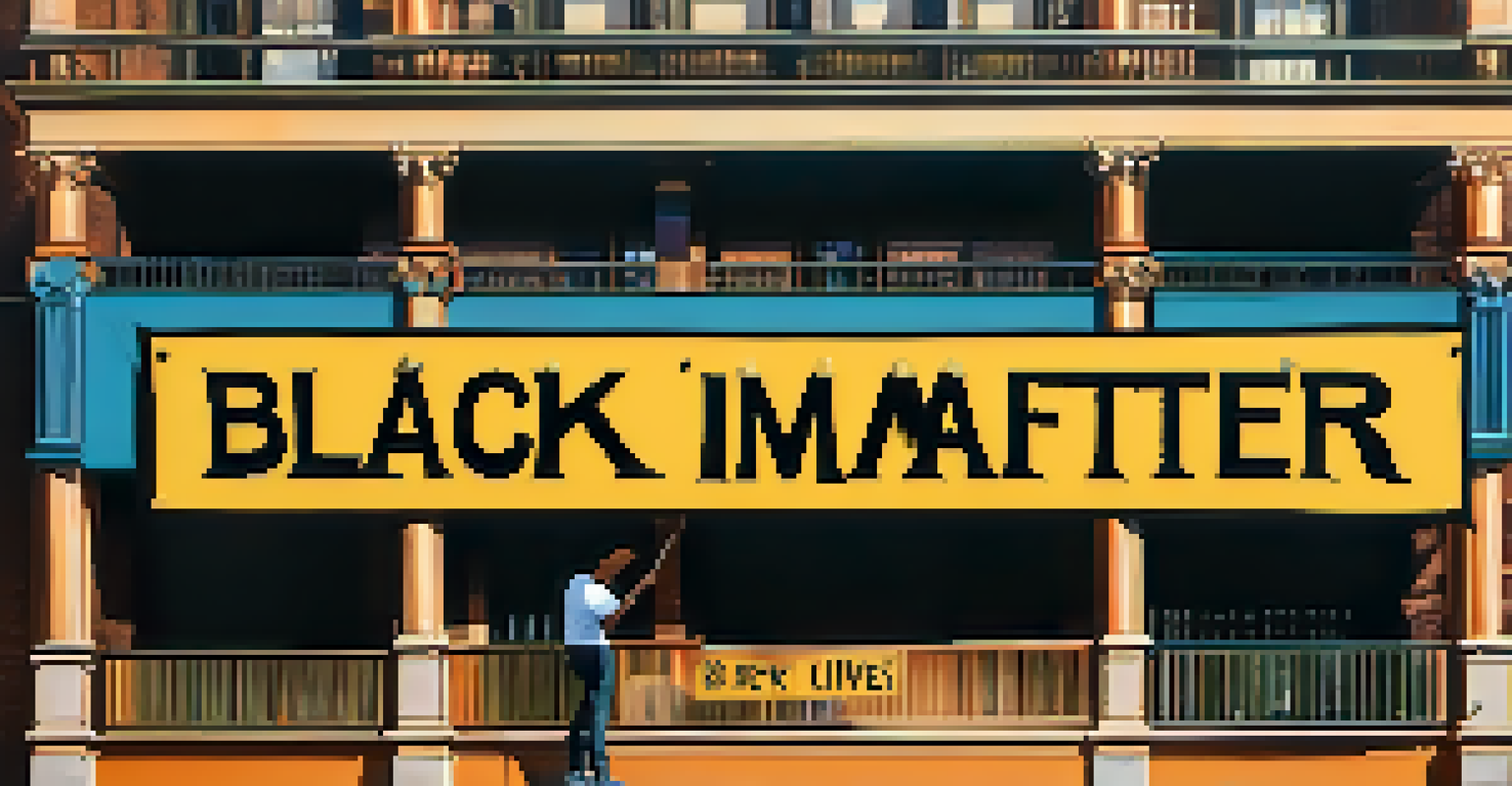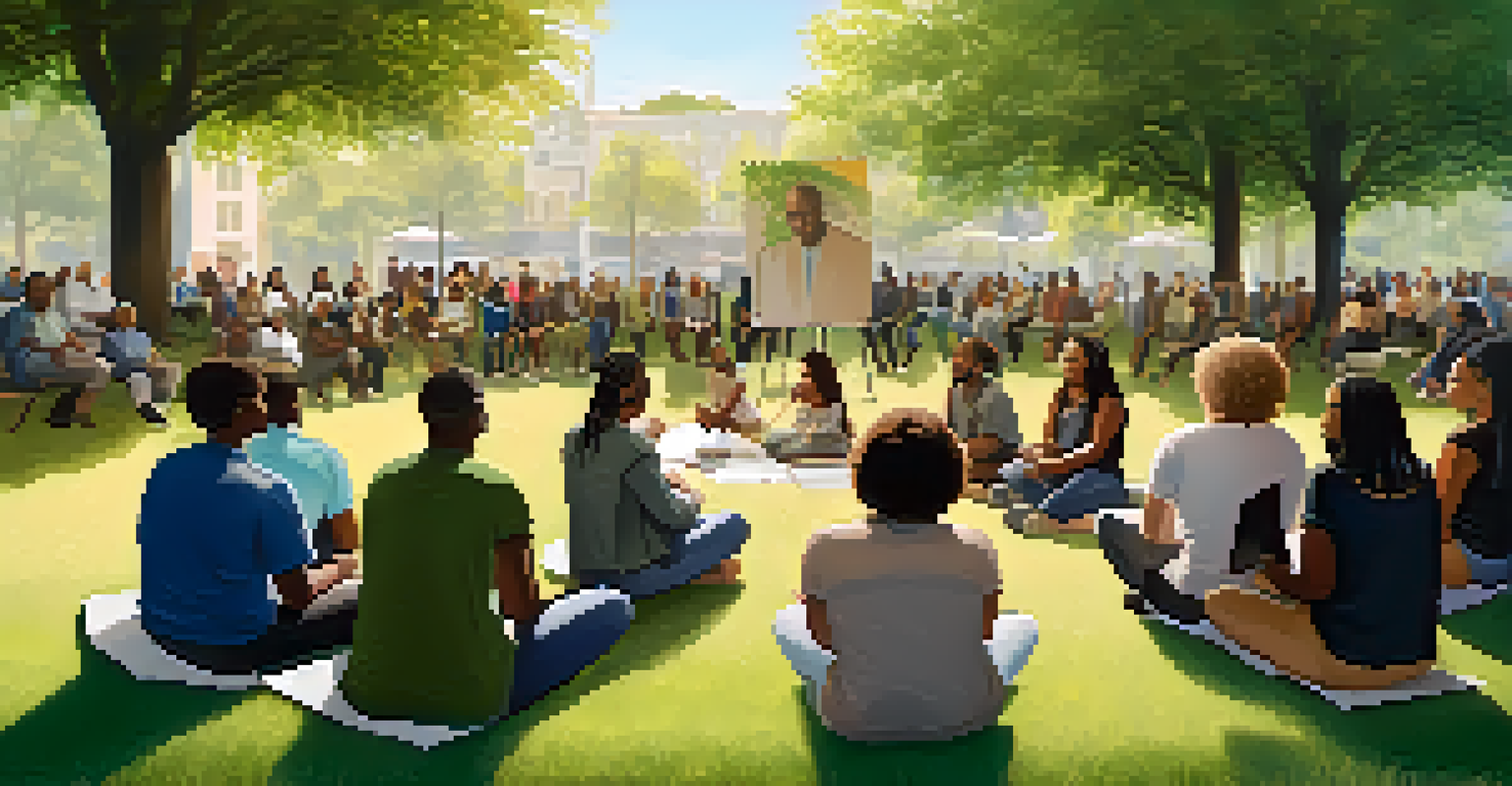Black Lives Matter: NYC's Ongoing Fight for Racial Justice

The Birth of the Black Lives Matter Movement
The Black Lives Matter (BLM) movement emerged in 2013, ignited by the acquittal of George Zimmerman in the shooting death of Trayvon Martin. This grassroots organization quickly spread across the nation, advocating for an end to violence and systemic racism against Black individuals. In New York City, the movement found fertile ground, resonating with locals who had long experienced racial injustice.
Injustice anywhere is a threat to justice everywhere.
BLM’s message is clear: Black lives matter, and they matter just as much as any other life. This simple yet profound statement has sparked conversations, protests, and a renewed commitment to fighting racial inequality. Over the years, NYC residents have rallied together to support this cause, highlighting the urgent need to address the disparities that persist in their communities.
The movement is not just about protests; it’s a call to action for everyone to reflect on their role in combating racism. Local leaders, activists, and everyday citizens have joined forces, demonstrating that the fight for equality is a collective effort. By uniting under the BLM banner, they aim to create lasting change in NYC and beyond.
Protests and Their Impact on NYC Communities
The protests that erupted in New York City, especially in the wake of George Floyd's death in 2020, were monumental. Thousands of New Yorkers took to the streets, expressing their anger and frustration over systemic racism and police brutality. These gatherings were not just about mourning; they were a vibrant display of solidarity and determination for justice.

The impact of these protests has been significant, both socially and politically. They have prompted discussions among city leaders about reforming policing practices and addressing the root causes of racial inequality. For many participants, the protests represented a turning point, galvanizing them to become more active in their communities and engage in advocacy efforts.
BLM Sparked Nationwide Conversations
The Black Lives Matter movement has ignited crucial discussions around racial inequality and systemic racism across the U.S.
Moreover, the protests have encouraged individuals to educate themselves and others about racial issues. Whether through social media campaigns, community meetings, or educational workshops, the momentum from these demonstrations has fostered a greater understanding of the challenges faced by Black communities in NYC. This shift in awareness is crucial for sustaining the fight for justice.
The Role of Local Organizations in the Movement
Local organizations have been pivotal in amplifying the voices of marginalized communities in NYC. Groups like the New York Civil Liberties Union and Color of Change have worked tirelessly to advocate for policy changes that promote racial equity. Their efforts provide essential resources and support to those directly affected by systemic racism.
The time is always right to do what is right.
These organizations often collaborate with grassroots movements, ensuring that the demands of the community are at the forefront. They offer platforms for community members to share their stories and experiences, fostering a sense of empowerment and unity. This collaborative approach strengthens the movement, making it more inclusive and representative of the diverse voices within the city.
Additionally, local organizations conduct research and provide data that highlight the disparities faced by Black New Yorkers. By grounding their advocacy in facts, they can better persuade policymakers and the public to take action. This strategic use of information reinforces the need for systemic change, making it a powerful tool in the fight for justice.
The Influence of Social Media on Racial Justice Advocacy
Social media has transformed how movements like Black Lives Matter engage with the public. Platforms like Twitter, Instagram, and Facebook have allowed activists to share information quickly and connect with a wider audience. This digital space has been vital for organizing events, sharing resources, and raising awareness about racial injustices.
During protests, social media played a crucial role in documenting events in real-time, providing firsthand accounts of police interactions, and highlighting instances of brutality. These posts not only informed the public but also held law enforcement accountable, creating a sense of transparency. The viral nature of these posts has often led to global attention on local issues, amplifying the call for change.
Protests Drive Legislative Change
Mass protests in NYC have led to significant legislative reforms aimed at increasing police accountability and addressing racial injustice.
Furthermore, social media has helped educate individuals about the complexities of racial issues. Informative threads, videos, and graphics have sparked discussions and motivated many to learn more about systemic racism. This accessibility to information has empowered a new generation of activists, ensuring that the movement continues to grow and evolve.
Legislative Changes Driven by BLM in NYC
The Black Lives Matter movement has not only sparked public protests but has also influenced legislative changes in New York City. Activists have tirelessly pushed for reforms aimed at reducing police violence and increasing accountability. As a result, several policies have been introduced, aiming to enhance transparency and promote equitable treatment.
One notable example is the ban on chokeholds, which was enacted in response to the outcry over Eric Garner's death in 2014. This legislation is just one of many that demonstrate the tangible impact of grassroots activism on local governance. By continuing to hold public officials accountable, BLM advocates ensure that the voices of the community are heard in the decision-making process.
Moreover, the movement has inspired broader discussions about funding priorities within the city’s budget. Advocates are calling for a reallocation of funds from policing to community programs that address systemic issues such as education, housing, and health care. This shift in focus aims to dismantle the systemic barriers that contribute to racial inequality.
Community Engagement and Grassroots Initiatives
Community engagement is at the heart of the Black Lives Matter movement in NYC. Grassroots initiatives have emerged, empowering local residents to take an active role in advocating for racial justice. From organizing town halls to hosting workshops, these initiatives are fostering dialogue and encouraging participation in the movement.
Many grassroots organizations focus on building community resilience by providing resources, support, and education. They create safe spaces where individuals can discuss their experiences and learn about their rights. This grassroots approach not only strengthens community bonds but also equips residents with the tools needed to advocate for themselves.
Community Engagement Fuels Activism
Grassroots initiatives in local communities are empowering residents to take active roles in advocating for racial justice and equality.
Moreover, these initiatives often highlight the intersectionality of racial justice, addressing issues such as economic disparity, housing, and healthcare. By recognizing that these problems are interconnected, activists can develop comprehensive solutions that benefit the entire community. This holistic approach ensures that the fight for racial justice is inclusive and addresses the needs of all marginalized groups.
Looking Ahead: The Future of Racial Justice in NYC
As the Black Lives Matter movement continues to evolve, the future of racial justice in NYC remains hopeful yet challenging. Activists are committed to sustaining the momentum generated over the past few years, recognizing that change requires ongoing effort and dedication. The lessons learned from past struggles serve as a foundation for future actions.
Community leaders are focusing on building coalitions that unite various organizations and individuals under a common goal. This collaborative spirit is crucial for amplifying the movement’s impact and ensuring that diverse voices are represented. By working together, activists can tackle the multifaceted issues of racial injustice and advocate for comprehensive reforms.

The journey toward racial justice is long, but the commitment of New Yorkers to this cause is unwavering. Through education, advocacy, and community engagement, the fight for equality will continue to shape the cultural and political landscape of the city. As history has shown, the power of collective action can bring about profound change, and NYC is poised to be at the forefront of this ongoing battle.